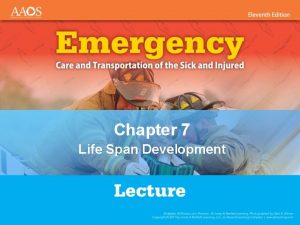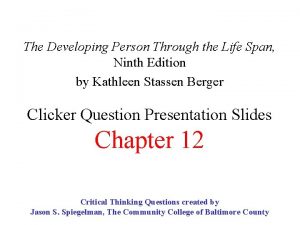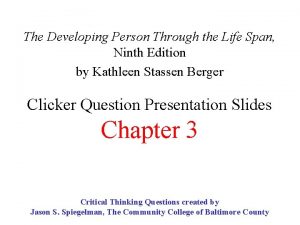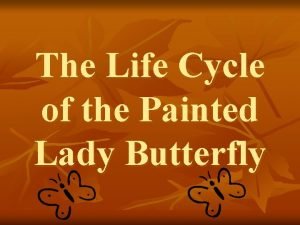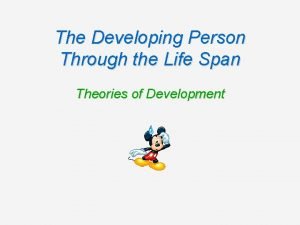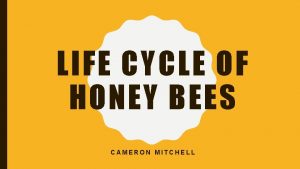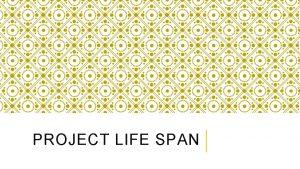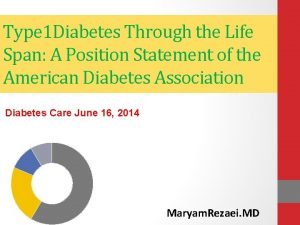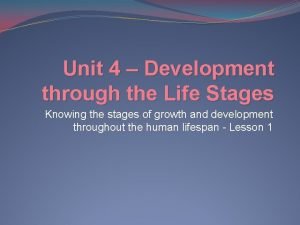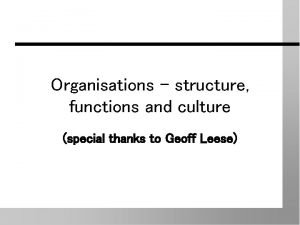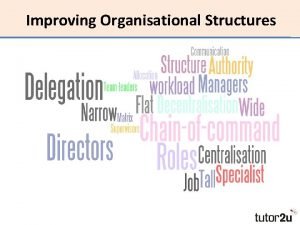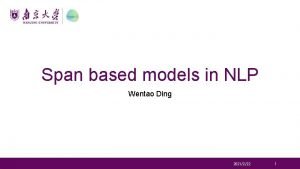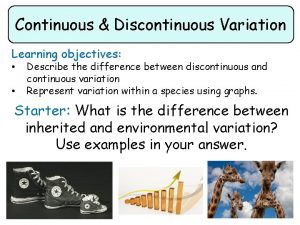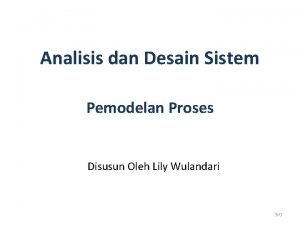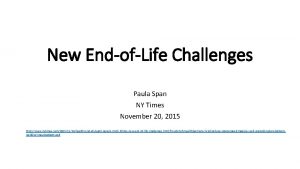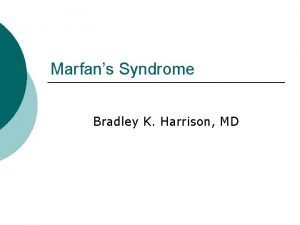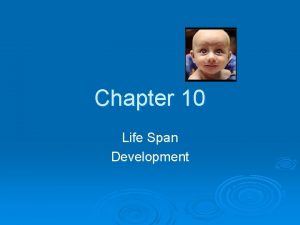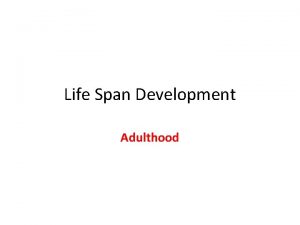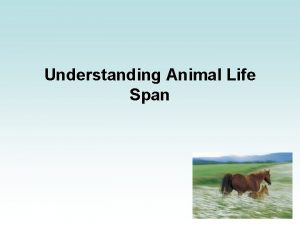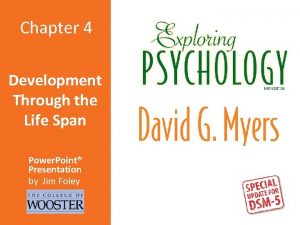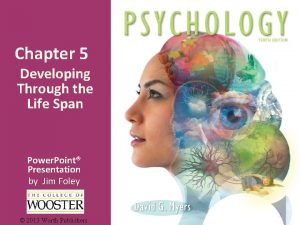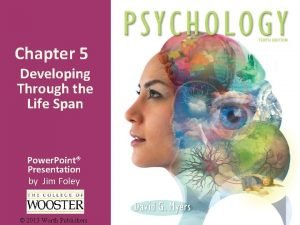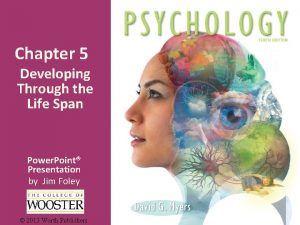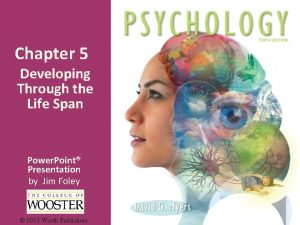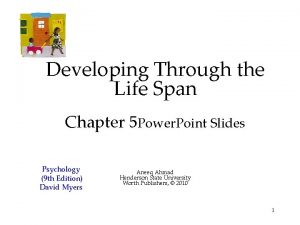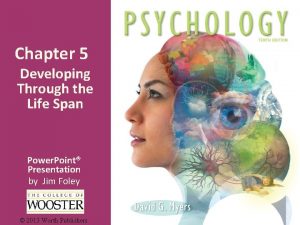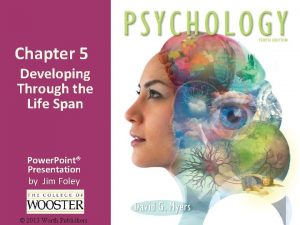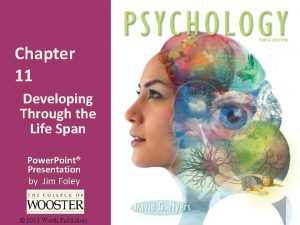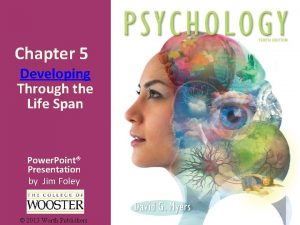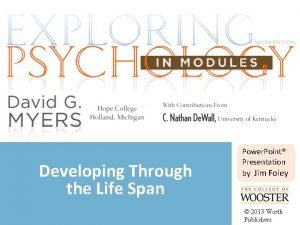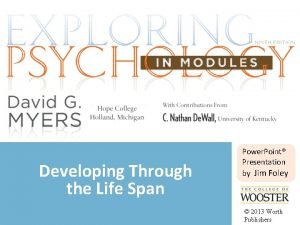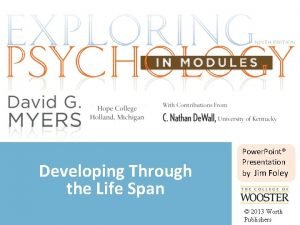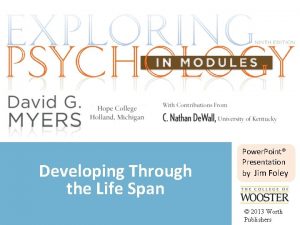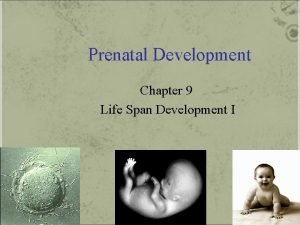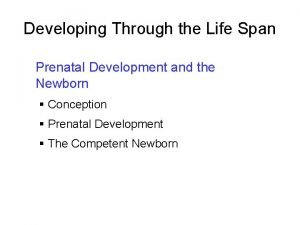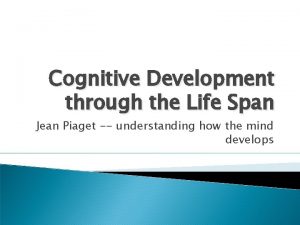Chapter 4 Development Through the Life Span Power



































































































- Slides: 99

Chapter 4 Development Through the Life Span Power. Point® Presentation by Jim Foley

Developmental Issues, Prenatal Development, and the Newborn Topics we’ll be bringing to life § Issues in Thinking about Development § Nature and Nurture § Continuity and Stages § Stability and Change § Prenatal Development § Conception Zygote § Embryo Fetus § Teratogen Risks § Newborn Skills and Behaviors

nature and nurture Issues in Developmental Psychology How do genes and experience guide development over our lifespan? change and stability continuity and stages In what ways do we change as we age, and in what ways do we stay the same? Is development a gradual change or are there some leaps to a new way of thinking or behaving?

Starting the Path to Personhood: Prenatal Development and the Newborn Conception Prenatal Development The Competent Newborn

In the beginning: Conception Sperm and egg unite to bring genetic material together and form one organism: the zygote (the fertilized cell).

Prenatal Development The Zygote Stage: First 10 to 14 Days § After the nuclei of the egg and sperm fuse, the cell divides in 2, 4, 8, 16, 100… § Milestone of the zygote stage: cells begin to differentiate into specialized locations and structures Implantation: The Embyro, 2 to 8 weeks § This stage begins with the multicellular cluster that implants in the uterine wall. § Milestone of the implantation stage: differentiated cells develop into organs and bones Embryo

The Fetus At nine weeks, hands and face have developed; the embryo is now called a fetus (“offspring”). Placenta At 4 months, many more features develop. Milestone of the fetal stage: by six months, the fetus might be able to survive outside the womb

Fetal Life: The Dangers • Teratogens (“monster makers”) are substances such as viruses and chemicals that can damage the developing embryo or fetus. • Fetal Alcohol Syndrome (FAS) refers to cognitive, behavioral, and body/brain structure abnormalities caused by exposure to alcohol in the fetal stage.

Fetal life: Responding to Sounds § Fetuses in the womb can respond to sounds. § Fetuses can learn to recognize and adapt to sounds that they previously heard only in the womb. § Fetuses can habituate to annoying sounds, becoming less agitated with repeated exposure.

The Competent Newborn Inborn Skills Reflexes are responses that are inborn and do not have to be learned. Newborns have reflexes to ensure that they will be fed. § The rooting reflex--when something touches a newborn’s cheek, the infant turns toward that side with an open mouth. § The sucking reflex can be triggered by a fingertip. § Crying when hungry is the newborn talent of using just the right sounds to motivate parents to end the noise and feed the baby.

More Inborn Abilities § Newborns (one hour old!) will look twice as long at the image on the left. § What can we conclude from this behavior?

Aspects of starting to grow up § Physical Development/maturation, inc. brain § Cognitive Development: Piaget, Vygotsky § Sensorimotor, Preoperational, Concrete Operational, Formal Operational Stages § Egocentrism, Theory of Mind, Autism Spectrum Disorder § Vygotsky: Mind in Social Context § Social Development § Attachment: Origins, Styles, Deprivation § Day Care; Self-Concept; Parenting Styles

Infancy and Childhood Infancy: newborns growing almost into toddlers Childhood: toddlers growing almost into teenagers For each of these stages, we will study: § brain development. § motor development. § cognitive development. § social and emotional development.

Maturation: not the meaning you might think § In psychology, “maturation” refers to changes that occur primarily because of the passage of time. § In developmental psychology, maturation refers to biologically-driven growth and development enabling orderly (predictably sequential) changes in behavior. § Experience (nurture) can adjust the timing, but maturation (nature) sets the sequence. Maturation in infancy and early childhood affects the brain and motor skills. For example, infant bodies, in sequence, will lift heads, then sit up, then crawl, and then walk. Maturation, the biological unfolding, will be seen in: § brain development. § motor development.

Brain Development: Building and Connecting Neurons § In the womb, the number of neurons grows by about 750, 000 new cells per minute in the middle trimester. § Beginning at birth, the connections among neurons proliferate. As we learn, we form more branches and more neural networks. § In infancy, the growth in neural connections takes place initially in the less complex parts of the brain (the brainstem and limbic system), as well as the motor and sensory strips. This enables body functions and basic survival skills. § In early childhood, neural connections proliferate in the association areas. This enables advancements in controlling attention and behavior (frontal lobes) and also in thinking, memory, and language.

Experience and Brain Development Rats living in an “enriched” environment (more social interaction and physical play) experienced a greater growth in brain size and complexity than those rats living in an “impoverished” environment.

Motor Development § Maturation takes place in the body and cerebellum enabling the sequence below. § Physical training generally cannot change the timing.

Baby Memory Infantile Amnesia § In infancy, the brain forms memories so differently from the episodic memory of adulthood that most people cannot really recall memories from the first three years of life. § A birthday party when turning three might be a person’s first memory. Learning Skills § Infants can learn skills (procedural memories). § This three month old can learn, and recall a month later, that specific foot movements move specific mobiles.

Cognitive Development Cognition refers to the mental activities that help us function, including: § problem-solving. § figuring out how the world works. § developing models and concepts. § storing and retrieving knowledge. § understanding and using language. § using self-talk and inner thoughts.

Cognitive Development: Jean Piaget (1896 -1980) § We don’t start out being able to think like adults. § Jean Piaget studied the errors in cognition made by children in order to understand in what ways they think differently than adults. The error below is an inability to understand scale (relative size).

Jean Piaget and Cognitive Development: Schemas § An infant’s mind works hard to make sense of our experiences in the world. § An early tool to organize those experiences is a schema, a mental container we build to hold our experiences. § Schemas can take the form of images, models, and/or concepts. This child has formed a schema called “COW” which he uses to think about animals of a certain shape and size.

Jean Piaget and Cognitive Development:

The Course of Development: Stages Jean Piaget believed that cognitive development: 1. is a combination of nature and nurture. Children grow by maturation as well as by learning through interacting/playing with the environment. 2. is not one continuous progression of change. Children make leaps in cognitive abilities from one stage of development to the next. Issue Nature vs. Nurture Continuity vs. Stages Jean Piaget’s Vote Both Stages

Jean Piaget’s Stages of Cognitive Development

Sensorimotor Stage (Birth to Age 2) In this stage, children explore by looking, hearing, touching, mouthing, and grasping. Cool cognitive trick learned at 6 to 8 months, coming up next: object permanence.

There’s a game I’ve learned to play all by myself: peekaboo! Object Permanence Through games like “peekaboo, ” kids learn object permanence--the idea that objects exist even when they can’t be seen. Hmm, a bear, should I put it in my mouth?

Can Children Think Abstractly? Jean Piaget felt that kids in the sensorimotor stage did not think abstractly. Yet there is some evidence that kids in this stage can notice violations in physics (such as gravity). Does that mean babies are doing physics?

What can kids do in the preoperational stage? 1. Represent their schema with words and images. 2. Perform pretend play. 3. Picture other points of view, replacing egocentrism with theory of mind. 4. Use intuition, but not logic and abstraction yet.

Maturing beyond Egocentrism: Developing a “Theory of Mind” Theory of mind refers to the ability to understand that others have their own thoughts and perspective. With a theory of mind, you can picture that Sally will have the wrong idea about where the ball is.

Examples of Operations that Preoperational Children Cannot Do…Yet Conservation refers to the ability to understand that a quantity is conserved (does not change) even when it is arranged in a different shape. Which row has more mice?

Autism Spectrum Disorder § Children with disorders on the autism spectrum have difficulties in three general areas: § establishing mutual social interaction § using language and play symbolically § displaying flexibility with routines, interests, and behavior § Children with ASD have more difficulty than a typical child in mentally mirroring the thoughts and actions of others; this difficulty has been called “mind blindness. ”

Happy train How do we teach social/emotional understanding to children with ASD? Are the kids with ASD learning to understand the emotions of others, or are they memorizing that certain facial positions correspond to certain emotion words?

The Concrete Operational Stage § begins at ages 6 -7 (first grade) to age 11 § children now grasp conservation and other concrete transformations § they also understand simple mathematical transformations the reversibility of operations (reversing 3 + 7 = 10 to figure out that 10 - 7 = 3).

Piaget’s stages of development

Views and uses of Piaget’s Theory Although Jean Piaget’s observation and stage theory are useful, today’s researchers believe: 1. development is a continuous process. 2. children show some mental abilities at an earlier age than Piaget thought. 3. formal logic is a smaller part of cognition, even for adults, than Piaget believed. Piaget helps us understand kids fairly. 3 year olds: § May break things without intending to; § Cannot tell that they are blocking your view, much less figuratively see from your viewpoint on issues; § May complain about a sibling getting more food if the same sized pizza was cut into more pieces. § May not get your sarcasm.

Lev Vygotsky: Alternative to Jean Piaget § Lev Vygotsky studied kids too, but focused on how they learn in the context of social communication. § Principle: children learn thinking skills by internalizing language from others and developing inner speech. § Vygotsky saw development as building on a scaffold of mentoring, language, and cognitive support from parents and others.

Social Development Stranger Anxiety Stranger anxiety develops around ages 9 to 13 months. In this stage, a child notices and fears new people. Explaining Stranger Anxiety How does this develop? § As children develop schemas for the primary people in their lives, they are more able to notice when strangers do not fit those schemas. However, they do not yet have the ability to assimilate those faces. Why does this develop? § An evolutionary psychologist would note that a child is learning to walk at this age. Some of the children who walked toward unfamiliar creatures might have died before having a chance to pass on genes.

Social Development: Attachment refers to an emotional tie to another person. § In children, attachment can appear as a desire for physical closeness to a caregiver. Origins of Attachment Experiments with monkeys suggest that attachment is based on physical affection and comfortable body contact, and not based on being rewarded with food.

Origins of Attachment: Familiarity § Most creatures tend to attach to caregivers who have become familiar. § Birds have a critical period, hours after hatching, during which they might imprint: become rigidly attached to the first moving object they see.

Attachment Variation: Styles of Dealing with Separation “Strange situations” test: 1. a mother and infant child are alone in an unfamiliar (“strange”) room; the child explores the room. 2. the mother leaves the room. 3. After a few moments, the mother returns. Reactions to Separation and Reunion § Secure attachment: mild distress when mother leaves, seeking contact with her when she returns § Insecure attachment (anxious style): not exploring, clinging to mother, loudly upset when mother leaves, remaining upset when she returns § Insecure attachment (avoidant style): seeming indifferent to mother’s departure and return

What causes these different attachment styles: nature or nurture? Is the “strange situations” behavior mainly a function of the child’s inborn temperament? § Temperament refers to a person’s characteristic style and intensity of emotional reactivity. § Some infants have an “easy” temperament happy, relaxed, and calm, with predictable rhythms of hunger and sleep. § Some infants seem to be “difficult”; they are irritable, with unpredictable needs and behavior, and intense reactions. Is the child’s behavior actually caused by previous parenting behavior? § Mary Ainsworth believed that sensitive, responsive, calm parenting is correlated with the secure attachment style. § Training in sensitive responding for parents of temperamentally-difficult children led to doubled rates of secure attachment.

Fathers Count Too § Many studies of the impact of parenting have focused on mothers. § Correlational studies show a strong relationship between paternal (father) involvement in parenting and the child’s academic success, health, and overall well-being.

Influences on Separation Anxiety Effects of Environment on Attachment Separation anxiety peaks and fades whether kids are at home or in day care.

Attachment Styles… not just about bonding with parents § Erikson’s concept of basic trust resembles the concept of attachment, but extends beyond the family into our feeling of whether the world is predictable and trustworthy. § Attachment style may be relevant to our ability to manage and enjoy adult relationships. Are basic trust and attachment styles determined in childhood? § Erikson believed that basic trust is established by relationships with early caregivers. § Are trust and attachment styles: § set by genetics? § formed by early experiences with parents? § reshaped by new relationship experiences?

Deprivation of Attachment § If children live without safe, nurturing, affectionate caretaking, they may still be resilient, that is bounce back, attach, and succeed. § However, if the child experiences severe, prolonged deprivation or abuse, he or she may: § have difficulty forming attachments. § have increased anxiety and depression. § have lowered intelligence. § show increased aggression.

Children in Day Care § We have seen already that time in day care does not significantly increase or decrease separation anxiety. § Warm interaction with multiple caretakers can result in multiple healthy attachments. § Time in day care correlates with advanced thinking skills… and also with increased aggression and defiance.

Childhood: Parenting Styles Style Response to Child’s Behavior Authoritarian Parents impose rules “because I said so” “Too Hard” and expect obedience. Permissive Parents submit to kids’ desires, not enforcing “Too Soft” limits or standards for child behavior. Parents enforce rules, limits, and standards Authoritative but also explain, discuss, listen, and express “Just Right” respect for child’s ideas and wishes.

Outcomes of these Parenting Styles Style Authoritarian “Too Hard” Permissive “Too Soft” Authoritative “Just Right” Long term outcomes for the child Rebellion, compulsivity, identity issues. Legal trouble, substance abuse, disorganization, unemployment. Internalized rules, self-discipline, follow through, life planning.

Outcomes with Parenting Styles § Authoritative parenting, more than the other two styles, seems to be associated with: § high self-reliance. § high social competence. § high self-esteem. § low aggression. § But are these a result of parenting style, or are parents responding to a child’s temperament? Or are both a function of culture ? Or genes?

Child-rearing: Cultural Differences § Individualist cultures: raising children to be selfreliant, independent and developing a personal identity. § In Western cultures, parents maintain control over parenting but might pay others to care for their children. § Collectivist cultures, e. g. Asia and Africa: raising children to be interdependent, developing a family self (what shames the child, shames the family). § Children in Africa and Asia are often raised in close physical contact with adults, but also raised later by siblings, integrated into webs of mutual support.

Nature, Nurture, and Differences § Childhood involves a genetically-driven process of maturation, AND a process of interacting with, and being formed by, the world of objects and media, parents and peers. § When racial or ethnic or gender groups of people differ from each other in traits or abilities, the differences within groups tends to be greater than the difference between groups. Why? § The environment and culture affects all of us, but due to our similar biological heritage, it affects us in much the same way. § Genetic variations within groups affect traits and behavior more than the variations between groups.

Adolescence § § Teenage Topics Physical Development: Puberty and more Cognitive Development in Adolescence § Reasoning Power § Moral Intuition, Reasoning, and Action Social Development in Adolescence § Forming an Identity § Parent and Peer Relationships Emerging Adulthood

The next phase of development § Developmental psychologists used to focus attention only on childhood. § Lifespan perspective refers to the idea that development is a lifelong process. § The next phase of that process is adolescence. Are these kids adolescents yet? § the transition period from childhood to adulthood § the period of development ranging from puberty to independence

Adolescent Physical Development Puberty is the time of sexual maturation (becoming physically able to reproduce). During puberty, increased sex hormones lead to: § primary and secondary sex characteristics. § some changes in mood and behavior. As with other maturation, the sequence is more predictable than the timing. Effects of Early Physical Maturation: Boys who become strong/athletic early • become more popular and confident • Are at greater risk of substance abuse, delinquency, premature sexual activity. Girls whose bodies mature early may associate with older teens or be teased or taunted.

Adolescent Brain Development § During puberty, the brain stops automatically adding new connections, and starts pruning away the neurons and synapses that aren’t being used (Use them or lose them!) § The frontal lobes are still forming during this time, still becoming more efficient at conducting signals. § The adolescent brain is at its peak of learning ability but not fully able to inhibit impulses (good accelerator, bad brakes). “ Young man, go to your room and stay there until your cerebral cortex matures. ”

Adolescent Cognitive Development According to Jean Piaget, adolescents are in the formal operational stage. They use this reasoning to: § think about how reality compares to ideals. § think hypothetically about different choices and their consequences. § critique the reasoning of others. § debate matters of justice, meaning of life, and human nature.

Building Toward Moral Reasoning Adolescents see justice and fairness in terms of merit and equity instead of in terms of everyone getting equal treatment. Moral Intuition: Our reasoning may be directed by emotions, such as § disgust about evil acts, and § elevated feelings about generosity and courage. Lawrence Kohlberg’s Levels of Moral Reasoning Preconventional morality (up to age 9): “Follow the rules because if you don’t, you’ll get in trouble; if you do, you might get a treat. ” Conventional morality (early adolescence): “Follow the rules because we get along better if everyone does the right thing. ” Postconventional morality (later adolescence and adulthood): “Sometimes rules need to be set aside to pursue higher principles. ”

Building Toward Moral Reasoning § Adolescents see justice and fairness in terms of merit and equity instead of in terms of everyone getting equal treatment. § Adolescents may strive to advocate for ideals and political causes. § Adolescents think about god, meaning, and purpose in deeper terms than in childhood. Lawrence Kohlberg’s Levels of Moral Reasoning Preconventional morality (up to age 9): “Follow the rules because if you don’t, you’ll get in trouble; if you do, you might get a treat. ” Conventional morality (early adolescence): “Follow the rules because we get along better if everyone does the right thing. ” Postconventional morality (later adolescence and adulthood): “Sometimes rules need to be set aside to pursue higher principles. ”

Example: looting after a natural disaster Which level of moral reasoning is involved? § Looting is a problem; if everyone did it, there would be escalating chaos and greater damage to the economy. § Looting is generally wrong, yet morally right when your family’s survival seems to depend on it. § Looting is wrong because you might get punished, but if no one is punished, that’s a sign that it’s okay.

Moral Intuition § Jonathan Haidt believed moral decisions are often driven by moral intuition, that is, quick, gut-feeling decisions. § This intuition is not just based in moral reasoning but also in emotions such as: § disgust. We may turn away from choosing an action because it feels awful. § elevated feelings. We may get a rewarding delight from some moral behavior such as donating to charity. An Example of Moral Intuition: Given a hypothetical choice to save five people from an oncoming trolley by killing one person, many people’s choice is determined not just by reasoning, but by disgust. Many people would flip a switch to make this choice, but not as many would push a person on the tracks to save five others.

Moral Action: Doing the Right Thing Character education: what helps people choose principled actions over selfishness or social pressure? Experience serving others/the greater good Empathy for the feelings of others Delaying gratification to plan for larger goals Selfdiscipline, or the ability to resist impulses

Psychosocial Development: Erikson’s Stages § Each age involves an “issue, ” a psychological challenge in managing our interaction with the social world. § The “vs. ” part: there is tension between two opposing tendencies. § Successfully resolving this tension gives us strengths that help us move to the next stage. § Not resolving this tension can lead to lifelong emotional and social difficulties.

Social Development: Erikson § Erikson’s model of lifelong psychosocial developmentsees adolescence as a struggle to form an identity, a sense of self. § Adolescents may in different roles with peers, with parents, and with teachers, try out different “selves. ” § For Erikson, the challenge in adolescence is to test and integrate the roles/selves in order to prevent role confusion (which of those selves, or what combination, is really me? ).

Erikson: Stages of Psychosocial Development

Other Eriksonian stages on the minds of adolescents While currently in the identity vs. role confusion stage, § adolescents have ideally just finished working through the tension of competence vs. inferiority. § They are ready after adolescence to take on the challenge of intimacy vs. isolation.

Peer Influence § The degree of peer influence is hard to trace. Apparent conformity (the whole group smokes) could be a selection effect (they get together because they want to be with others who like to smoke). § Interaction with peers can teach new social skills. § Parents may try to have indirect influence by selecting a child’s peers, such as by selecting a school or neighborhood. However, ultimately, most children self-select their peers.

Influences on Identity: Parent and Peer Relationships § During adolescence, peer relationships take center stage. § Conflicts arise in this stage, especially with first born children. § The challenge: finding how adolescent relationships with peers and with parents can coexist well, rather than being in conflict.

Parents vs. Peers Battling over non-genetic influence Parents have more influence on: Education and career path Cooperation Self-discipline Responsibility Charitableness Religion Style of interaction with authority figures Peers have more influence on: Learning cooperation skills Learning the path to popularity Choice of music and other recreation Choice of clothing and other cultural choices Good and bad habits

Adolescence, the sequel… Emerging Adulthood In some countries, added years of education and later marriage has delayed full adult independence beyond traditional adolescence. This seems to have created a new phase which can be called emerging adulthood, ages 18 -25.

Stages and Continuity § Three different types of development--cognitive, moral, and psychosocial--have been running in parallel. § Are they really separate stages, or a continuous process of development?

Continuity vs. Stages Researchers who see development as a function of experience tend to see development as continuous and gradual. Nurture is continuous. Researchers who focus on biological maturation see spurts of growth and other changes that make one stage of development very different from another. Nature has stages.

Adulthood Topics Grown-Ups Think About § Physical Changes in Middle Adulthood and in Later Life: Life expectancy, Sensory changes, Neurocognitive Disorders (Dementias) including Alzheimer’s Disease § Cognitive Development and decline § Social Development: Love, Work § Well-Being across the Lifespan § Dying and Death

Adulthood Is the rest of the developmental story just one long plateau of work and possibly raising kids? § Physical Development § physical decline § lifespan and death § sensory changes § Cognitive Development § memory § Social Development § commitments

Adult Physical Development § In our mid-20 s, we reach a peak in the natural physical abilities which come with biological maturation: § muscular strength § cardiac output § reaction time § sensory sensitivity § To what extent can training overcome the decline that follows?

Physical Changes: Middle Adulthood Between ages 40 and 60, physical vitality (such as endurance and strength) may still be more of a function of lifestyle than of biological decline. Some changes are still driven by genetic maturation, especially the end of our reproductive years. The end the reproductive years § There is a gradual decline in sexual activity in adulthood, although sexuality can continue throughout life. § Around age 50, women enter menopause (the end of being able to get pregnant). § According to evolutionary psychologists, why might it make sense for women’s fertility to end?

The Aging Body § Potential lifespan for the human body is estimated to be about 122 years. § Life expectancy refers to the average expected life span. § The worldwide average has increased from 49 in 1950 to 69 in 2010. In 2012: South Africa— 49 Cameroon— 55 Pakistan— 66 Thailand--74 United States--75 Ireland--80 Australia— 82 Japan--84 More Aged Women § The rise in life expectancy, combined with declining birth rates, means a higher percentage of the world’s population is old. § More elderly people are women because more men die than women at every age. By age 100, women outnumber men by a ratio of 5 to 1.

Why don’t we live forever? Possible biological answers… § Nurture/Environment An accumulation of stress, damage, and disease wears us down until one of these factors kills us. § Genes Some people have genes that protect against some kinds of damage. § Even with great genes and environment, telomeres (the tips at the end of chromosomes) wear down with every generation of cell duplication and we stop healing well.

The Death-Deferral Phenomenon Can people will themselves to hold off death? There is some evidence that some people are able to stay alive to be with families at Christmas time.

Physical Changes with Age The following abilities decline as we age: § visual acuity, both sharpness and brightness § hearing, especially sensing higher pitch § reaction time and general motor abilities § neural processing speed, especially for complex and novel tasks

Impact of Sensory and Motor Decline What specific factors and changes might explain the results below? Age

Health/Immunity Changes with Age The bad news The immune system declines with age, and can have difficulty fighting off major illnesses. The good news The immune system has a lifetime’s accumulation of antibodies, and does well fighting off minor illnesses.

Exercise Can Slow the Aging Process Exercise can: § build muscles and bones. § stimulate neurogenesis (in the hippocampus) and new neural connections. § maintain telomeres. § improve cognition. § reduce the risk of dementia.

Changes in the Brain with Age § Myelin-enhanced neural processing speed peaks in the teen years, and declines thereafter. § Regions of the brain related to memory begin to shrink with age, making it harder to form new memories. § The frontal lobes atrophy, leading eventually to decreased inhibition and self-control. § By age 80, a healthy brain is 5 percent lighter than a brain in middle adulthood.

Neurocognitive Disorders: Alzheimer’s Disease and Other Dementias Dementia, including the Alzheimer’s type, is NOT a “normal” part of aging. Dementia Symptoms § decreased ability to recall recent events and the names of familiar objects and people § emotional unpredictability; flat, then uninhibited, then angry § confusion, disorientation, and eventual inability to think or communicate § § Brain Changes of Alzheimer’s Disease loss of brain cells and neural network connections deterioration of neurons that produce acetylcholine, the memory neurotransmitter shriveled and broken protein filaments forming plaques at the tips of neurons dramatic shrinking of the brain

Cognitive Development and Memory § Even without the brain changes of dementia, there are some changes in our ability to learn, process, and recall information. § The ability to recognize information, and to use previous knowledge as expertise, does not decline with age. Can you describe and explain the differences in performance changes in these charts?

More Learning and Memory Changes § Rote memorization ability declines more than ability to learn meaningful information. § Prospective memory, planning to recall, (“I must remember to do…) also declines. § The ability to learn new skills declines less than the ability to learn new information.

Comparing Young and Old People § Cross-sectional studies compare people at different ages all at one time. § What disadvantages can you see with this method? Hint: when, and how, were today’s 80 -year-olds raised? § Longitudinal studies compare the attributes of the same people as they change over time. Any disadvantages? Is it practical? Is it generalizable?

Social Development in Adulthood Is adult social development driven by biological maturation or by life experiences and roles? § The “midlife crisis”—re-evaluating one’s life plan and success—does not seem to peak at any age. § For the 25 percent of adults who do have this emotional crisis, the trigger seems to be the challenge of major illness, divorce, job loss, or parenting.

Psychosocial Development § Although the “midlife crisis” may not be a function of age, people do feel pressured by a “social clock” of achievement expectation. § Erikson’s observations of age-related issues:

Challenges of Healthy Adulthood Arising first: Erikson’s intimacy issue (a. k. a. affiliation, attachment, connectedness) Arising later: Erikson’s generativity issue (achievement, productivity, competence) Sigmund Freud used simpler terms, saying that the healthy adult must find ways to love and to work.

Commitment to Love § The desire to commit to a loving relationship may have evolved to help vulnerable human children survive long enough to reproduce. § Couples who go through marriage/union ceremonies tend to stay together more than couples who simply live together. § Marriage, compared to being single, is associated with ‘happiness’ and with fewer social problems such as crime and child delinquency. Commitment to Work § Work roles can largely define adult identity, especially in individualistic capitalist societies. § Tough economic times make it difficult to find work, much less follow a career path. § Work satisfaction seems to be a function of having the work fit a person’s interests and providing a sense of competence and accomplishment.

Well-Being across the Lifespan Life satisfaction, as measured by how close people feel to the “best possible life, ” is apparently not a function of age.

Why do people claim to be happy even as their body declines? § Older people attend less to negative information and more to positive information. § They are also more likely to have accumulated many mildly positive memories, which last longer than mildly negative memories. § Older people feel an increased sense of competence and control, and have greater stability in mood.

Managing the Aging Process: Biopsychosocial Factors Many factors can support well-being in old age.

Coping with Death and Dying Below is an average reaction to a spouse’s death.

Coping with Death and Dying Individual responses to death may vary. § Grief is more intense when death occurs unexpectedly (especially if also too early on the social clock). § There is NO standard pattern or length of the grieving process. § It seems to help to have the support of friends or groups, and to face the reality of death and grief while affirming the value of life.

Reflections on Change and Stability § Are there some parts of who we are that remain stable throughout development? Our temperament? Our overall personality? § Do some of our attributes change during development (even while we maintain our sense of identity)? Our abilities? Our interests? Our habits? Our traits?

The Final Issue in Development: Stability and Change Are we essentially the same person over long periods? § In general, temperament seems stable. § Traits can vary, especially attitudes, coping strategies, work habits, and styles of socializing. § Personality seems to stabilize with age. Stability helps us form identity, while the potential for change gives us control over our lives.

Photo Credits • • • Slide 2/Slide 5: Lennart Nilsson / Albert Bonniers Publishing Group Slide 6: Lennart Nilsson/Bonnier Fakta Bokforlag Slide 7: • • • • • • Slide 9: moodboard/Jupiter. Images Slide 17: Juice Images/Jupiter. Images Slide 18: Michael Newman / Photo Edit Slide 20: Courtesy of Judy De. Loache Slide 25: Image Source/Getty Images Slide 26: Doug Goodman Slide 29: Inspired by Baron- Cohen et al. , 1985 Slide 30: Bianca Moscatelli/Worth Publishers Slide 32: © Crown copyright MMVI, www. thetransporters. com, courtesy Changing Media Development Slide 37: © Christina Kennedy/Photo. Edit Slide 38: Harlow Primate Laboratory, University of Wisconsin Slide 39: Mark Peterson/Redux Slide 42: d 85/ZUMA Press/Newscom Slide 46: AP Photo/Imperial Valley Press, C Kate Nurre/Worth Publishers uauhtemoc Beltran Slide 53: Rob Lewine/Getty Images Slide 55: © The New Yorker Collection, 2006, Barbara Smaller from cartoonbank. com. All Rights Reserved. Slide 59: Reuters/Eduardo Munoz Slide 63: Tristan Savatier/Getty Images Slide 65: © Oliver Rossi/Corbis Slide 69: © The New Yorker Collection, 2007, William Haefeli from cartoonbank. com. All Rights Reserved. Slide 72: • • • – – Biophoto Associates/Science Source Lennart Nilsson/Albert Bonniers Publishing Company – – © Jose Luis Pelaez Inc/Blend Images/Corbis Lisa B. /Corbis Pascal Parrot/Sygma/Corbis Rick Doyle/ Corbis Slide 73: Barbara Smaller/Funny Times Slide 82: Rick Doyle/ Corbis Slide 83: Liquid. Library/ Jupiterimages Slide 84: Alan Oddie/Photo. Edit Slide 91: – – Hill Street Studios/Getty Images © Oliver Rossi/Corbis
 Chapter 7 life span development
Chapter 7 life span development The developing person through the life span 9th edition
The developing person through the life span 9th edition The developing person through the lifespan
The developing person through the lifespan The developing person through the life span 9th edition
The developing person through the life span 9th edition Painted lady butterflies life cycle
Painted lady butterflies life cycle Immortal jellyfish phylum
Immortal jellyfish phylum Lifespan of an eagle
Lifespan of an eagle Life span theories
Life span theories Bees life cycle
Bees life cycle Petit four display
Petit four display Project life span
Project life span Ozymandias summary line by line
Ozymandias summary line by line Life span type 1 diabetes
Life span type 1 diabetes Power triangle
Power triangle Maturation definition
Maturation definition Through one man
Through one man Furcation involvement
Furcation involvement What is the conversion of timber
What is the conversion of timber Night of the scorpion by nissim ezekiel summary
Night of the scorpion by nissim ezekiel summary Hình ảnh bộ gõ cơ thể búng tay
Hình ảnh bộ gõ cơ thể búng tay Slidetodoc
Slidetodoc Bổ thể
Bổ thể Tỉ lệ cơ thể trẻ em
Tỉ lệ cơ thể trẻ em Chó sói
Chó sói Glasgow thang điểm
Glasgow thang điểm Hát lên người ơi
Hát lên người ơi Các môn thể thao bắt đầu bằng từ đua
Các môn thể thao bắt đầu bằng từ đua Thế nào là hệ số cao nhất
Thế nào là hệ số cao nhất Các châu lục và đại dương trên thế giới
Các châu lục và đại dương trên thế giới Cong thức tính động năng
Cong thức tính động năng Trời xanh đây là của chúng ta thể thơ
Trời xanh đây là của chúng ta thể thơ Mật thư anh em như thể tay chân
Mật thư anh em như thể tay chân Phép trừ bù
Phép trừ bù độ dài liên kết
độ dài liên kết Các châu lục và đại dương trên thế giới
Các châu lục và đại dương trên thế giới Thơ thất ngôn tứ tuyệt đường luật
Thơ thất ngôn tứ tuyệt đường luật Quá trình desamine hóa có thể tạo ra
Quá trình desamine hóa có thể tạo ra Một số thể thơ truyền thống
Một số thể thơ truyền thống Cái miệng nó xinh thế
Cái miệng nó xinh thế Vẽ hình chiếu vuông góc của vật thể sau
Vẽ hình chiếu vuông góc của vật thể sau Thế nào là sự mỏi cơ
Thế nào là sự mỏi cơ đặc điểm cơ thể của người tối cổ
đặc điểm cơ thể của người tối cổ Ví dụ giọng cùng tên
Ví dụ giọng cùng tên Vẽ hình chiếu đứng bằng cạnh của vật thể
Vẽ hình chiếu đứng bằng cạnh của vật thể Fecboak
Fecboak Thẻ vin
Thẻ vin đại từ thay thế
đại từ thay thế điện thế nghỉ
điện thế nghỉ Tư thế ngồi viết
Tư thế ngồi viết Diễn thế sinh thái là
Diễn thế sinh thái là Các loại đột biến cấu trúc nhiễm sắc thể
Các loại đột biến cấu trúc nhiễm sắc thể Số nguyên tố là số gì
Số nguyên tố là số gì Tư thế ngồi viết
Tư thế ngồi viết Lời thề hippocrates
Lời thề hippocrates Thiếu nhi thế giới liên hoan
Thiếu nhi thế giới liên hoan ưu thế lai là gì
ưu thế lai là gì Hổ đẻ mỗi lứa mấy con
Hổ đẻ mỗi lứa mấy con Khi nào hổ mẹ dạy hổ con săn mồi
Khi nào hổ mẹ dạy hổ con săn mồi Hệ hô hấp
Hệ hô hấp Từ ngữ thể hiện lòng nhân hậu
Từ ngữ thể hiện lòng nhân hậu Thế nào là mạng điện lắp đặt kiểu nổi
Thế nào là mạng điện lắp đặt kiểu nổi Prefixspan algorithm
Prefixspan algorithm Cl signs
Cl signs Applegate classification
Applegate classification Factors affecting span of control
Factors affecting span of control Costophrenic angle tenderness
Costophrenic angle tenderness Definition of vector space
Definition of vector space Open web steel joist details
Open web steel joist details Wisc-v picture span subtest description
Wisc-v picture span subtest description Director or manager
Director or manager Surface marking of liver
Surface marking of liver Pitched roof truss design
Pitched roof truss design Classification of management functions
Classification of management functions Linear span of vectors
Linear span of vectors Wide vs narrow span of control
Wide vs narrow span of control Swing span
Swing span Renal angle
Renal angle A minimal span-based neural constituency parser
A minimal span-based neural constituency parser What is mud phuska
What is mud phuska Monitoring span
Monitoring span Uneven type greenhouse
Uneven type greenhouse Work and span
Work and span Applegates classification
Applegates classification Puddle sign
Puddle sign Linear combination of vector
Linear combination of vector Time span of augustan
Time span of augustan Prefix span
Prefix span Uneven span greenhouse
Uneven span greenhouse Structural components of greenhouse
Structural components of greenhouse Continuous and discontinuous variation worksheet
Continuous and discontinuous variation worksheet Manageable span of control refers to
Manageable span of control refers to Clear span of slab
Clear span of slab Mother any distance analysis
Mother any distance analysis Skip pointer information retrieval
Skip pointer information retrieval What is span of control
What is span of control What is span of control
What is span of control Bridge pylon
Bridge pylon C span cram for the exam
C span cram for the exam Paula span new york times
Paula span new york times Is your arm span your height
Is your arm span your height
